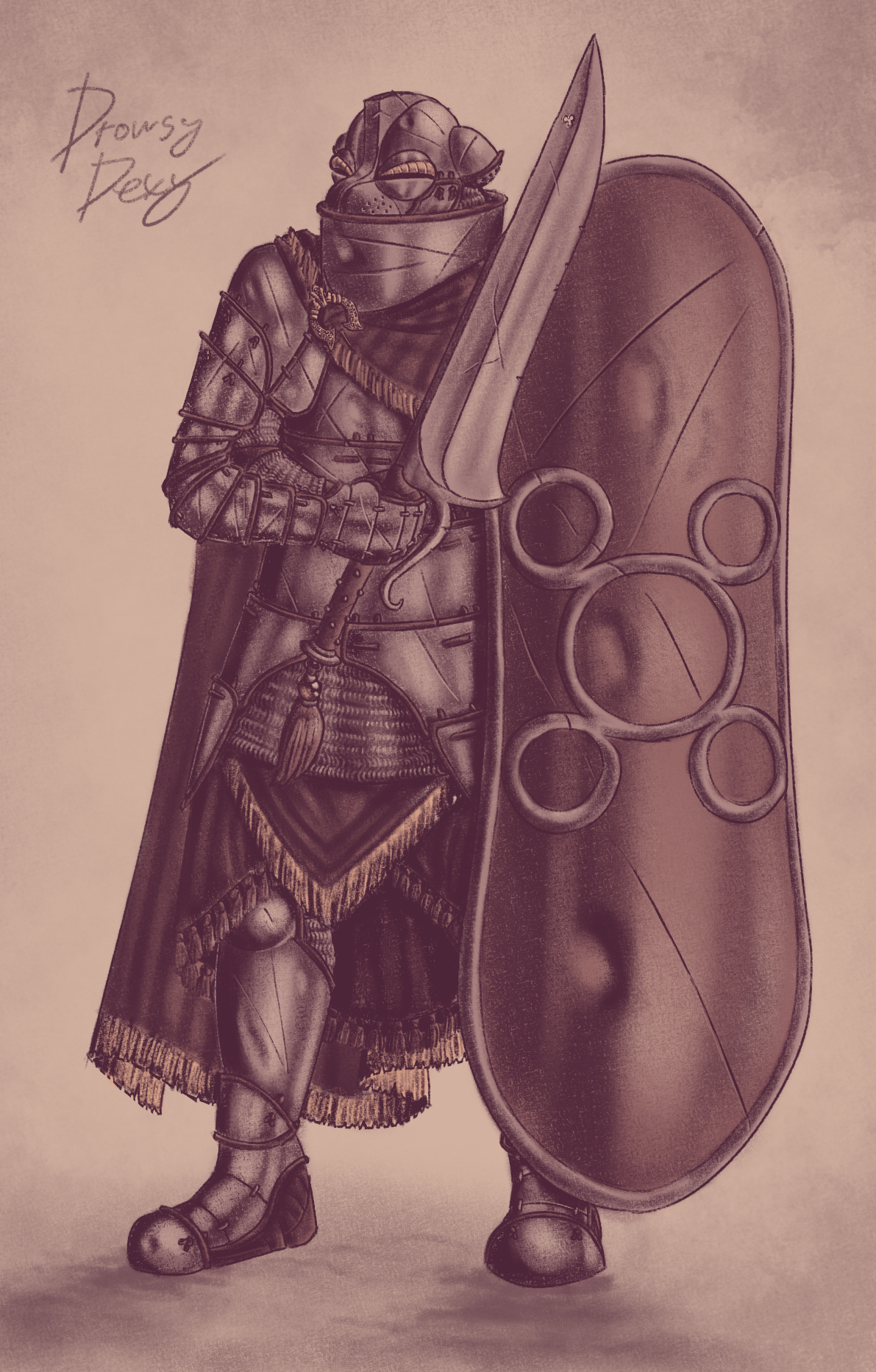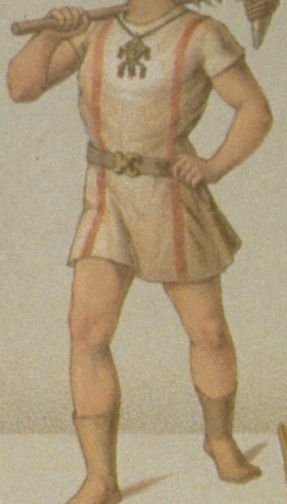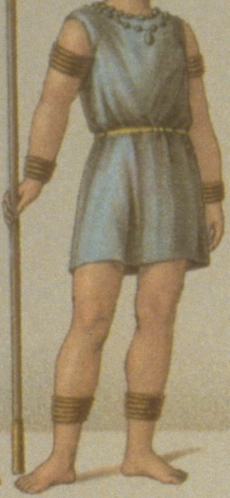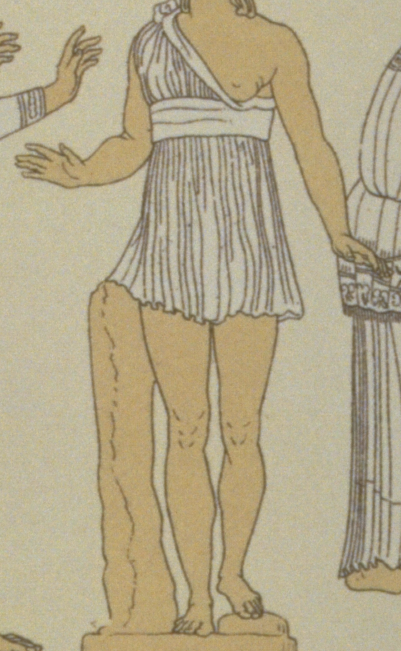 ORCS
ORCS

Often stereotyped as unthinking warlike brutes, not many would know much about utilitarianian and highly disciplined society of Orcs, who created one of, if not the most effiecient warmachine in the world. They despise anything they deem to be 'weak' and 'cowardly', prefering to trust in the strength of their arms and crafts, rather than magic and cultural endevours, and they won't hesitate to make these opinions known to their neighbours by way of war, and as such, they are considered savage and backwards by the rest of the world. They resemble hogs or wild pigs, easily towering over most of other races, and are the physicaly strongest of all beast races.
Orcish architecture is simple and extremely utilitarian. Roundhouses with mud and straw thatched roofing are common dwelling. Great castles are built for nobles and military installations.
Clothing in the orcish culture is characterized by an open, breathing design that allows for air to enter and for the body to effectively disperse heat. It is not uncommon for older orcs to not wear clothes, as nudity is seen as a sign of naturalistic purity and orcs closer to death actively seek out said purity, to grant them easier entrance to the afterlife.

Orcish armor is characterized by thick layering on top of their already hardy and well-protected fat and muscle covered bodies. Lesser soldiers employ leather and basic padding for armor, rarely chainmail. Orcish plate armor, usually used by high-ranking military members, is notably thick, enough to stop lead bullets and nullify some magical attacks. (Art made by DrowsyDexy! Click to enlarge)
description

Orcish royal attire often incorporates lots of jewlery, as well as the presence of a Greatcape, which is an especially extravagant cape often made from the hide of a very powerful beast or fine silks. Greatcapes come in two distinct styles, ones that cover from the neck down to the groin, draped over the entire body and another style that is exceptionally large that is worn down the back usually reserved for military-affiliated nobles like knights and kings.
Clothing in the orcish culture usually light and not form fitting, to allow their large bodies to disperse heat effectively.


Men’s
Male orcish clothing's primary standard is that it must cover the male's genitals. It is usually loose, and not form-fitting. Tusk binding, etching, and coloring are all very common for male orcs. Such practices are not allowed for females.
Women’s


Female orcish clothing's standards are that it must cover the female's genitals. Breasts are not seen as an obscene body part in orcish culture. It is usually loose, and not form fitting. Generally females will be adorned with bead necklaces and bracelets. Age is usually signified with the color and pattern of said beads.

The orcish language is defined by its hard consonants, intense bilabial sounds, and incorporation of squeals, grunts, and snorts. Orcish is a phonemic orthographical language, meaning that it is pronounced exactly as it is written. It operates off of a 17 letter alphabet. (Alphabet made by DrowsyDexy! Click to enlarge)
Creation Myth: The One God Gof died, and his intestines were used to create the world known as Tellus, with other organs being used to create many other worlds. Life that originally started as lower forms, such as worms and parasites eventually turned into more advanced life. It is said that orcs were created by Gof to be the dominating species of Tellus.
Cosmology: Flat earth, geocentric. Orcs believe that Tellus takes the form of a long-rotted pile of intestines within a gigantic basin of transparent ice, and that the sun and moons dance across the sky in a constant retelling of death and infinite rebirth of their god Gof.
Dead eldritch god, now undead within the underworld. God of all things and powerful over all things. His symbol is that of the sun, reflecting the natural, creating order. Colors associated with him are green and yellow, often checkered in designs.
The one of the last living remnants of Gof. Once spored from his body, the two gods gave birth to several others including Zedhel and Sogof. She is the goddess of fertility, prosperity, harvest, thought, and study. She is known to take the form of many other creatures in Tellus and sometimes may live among the mortals. Her symbols are that of cows and agricultural iconography. She is said to most commonly take the form of a humanoid female with the head of a cow.
Miscarriage of Gof and Malgat, an undead old god within the underworld. God of rain, swamps, mist, clouds, floods, and putrefaction. Several miscarriages are a sign that Sogof is angry. Their symbol is a spear thistle, usually painted in green. Only one sighting of Sogof's avatar is recorded, and it is said that they took the form of a mass of worms emerging from the eyesockets of a great orcish skull.
A god that is said to have spored directly from Gof's body before death, and as such is one of Gof's last living remnants. He is the god of war, blood, battle, masculinity, and indulgence. His symbols are that of a phallus or phallic imagery, unicorns, pigs, or spears.
A dreadful tree of flesh, with untold power. Chronicling on this god is not fully known, and this entry is subject to change...
Gof, after his death, fashioned his intestines into the world of Tellus. His organs were fashioned into many other celestial bodies, some not even known to modern science.
description
Zedhel is the strongest of Malgat's living children, and is the only surviving child.
Mafrit was the only child born of a physical body and thus was to be the most powerful. Its birth however was highly contested during the Chador-Tellock war, and the Chades succeeded in surrounding the infant god and capturing it.
Appearing only a once, Sogof's avatar is described as follows: "He appeared as a great skull the size of a galley with bright red worms with little white heads emerging from the eyesockets. The skull opened its mouth, and a green mist cascaded down onto the fighting ground. The Orcs and Chades all dropped dead." Later the contested territory was captured for Tellock, as another patrol arrived to find an entire battlefield suddenly devoid of life.
It is said that Zedhel killed the gods of every other pantheon and belief, or in Gofic belief, "The Degenerate Gods."
Literally translated as "maggots", these dreadful creatures are seen as extensions of the God Zedhel. Some believe that they are literally fecal matter or parasites that live inside Zedhel's fecal matter. They possess a pseudo-humanoid appearance with a great spear emerging from where genitals should be and a face that closely resembles a tightened sphincter. They possess no arms to begin with, but later may mature into a "greater maggot", where arm-like appendages grow and attach themselves to their genital spear, likely for better manipulation of it. These creatures mindlessly wander in search of victims, and when found, will skewer the victims to death in a sort of deranged act of sexual assault, all whilst proclaiming in ancient orcish tongue words of pleasure.
The end of the Chador-Tellock conflict was marked with the death of the infant god Mafrit at the hands of Galloman. Seeing its death at the hands of the Doomsayers imminent, Galloman decided to willingly kill the infant god by directing its power into Ser Magnus of Chador after the capture of Akkae-gnt keep. Upon rejecting the holy divinity that was merging with himself, Magnus became a demon. (cont)
Orcish churches are large, open circular structures with great frames supported by pillars Between each pillar a hanging decoration is held, each depicting an event in the story of Tellus by Gofic belef.
Orcs will often perform sacrifices of slaves and war prisoners to their gods, for favor or done in respect.
holidays tba
Due to the highly economic nature of their society, orcish traditional art is usually made with cheap materials or those found in nature by the artist. Orcs often tend to decorate not with art pieces, but with interesting things found throughout the orc's life, and in a warrior's case, war spoils. Orcish jewelry is crafted in an incredibly simple manner, without use of expensive materials such as gold and silver. Orcs refer to male friends as brothers and female friends as sisters. Village elders are known as "Fathers".
Orcish culture is male dominated. Combat roles are completely reserved for male orcs and labor roles (like agriculture or medicine) are reserved for female orcs. Female orcs are not allowed to become warriors. Orcs believe in complete a completely birth-identifying heterosexual society. Homosexuals and genderqueer individuals will be exiled, or in some cases killed. Homophobia and transphobia is aggressive in orc culture, and often this blends with their already isolationist mindset, such as with the elves.
Orcs operate in an extremely utilitarian manner. Economically they operate off of a loose socialist structure, to partial success. Villages operate less strongly under these structures than cities. In established cities, orcs will divide into political families that choose individuals to form a city commitee of elected speakers that will dictate the laws and standards of each family's political territory within the city as well as nearby villages and farms in a manner that is intended to be beneficial to the entirety of Tellock as a whole as well as the cities themselves.
Orcish views on family are unusual. Often the ties between their family and their community seem to blend. An entire tribe is considered a family, due to the closeness of orcish common life. Orcs are loyal to their friends, sometimes to a fault. Often, an individual in a village will be acquainted with every other individual of the village, which operate as large, extended families. Due to the nature of closeness this system creates, orcs are fiercely patrotic and loyal to their kind.
Orcs view cynocephali as a weak beastfolk with a conniving nature.
Some extremely zealous orcs tend to demonize dwarves because of the death of their god Malgat. Most have forgiven them for their original sin.
Elves in orcish culture are seen as weak, feminine, and perverted due to their willingness to accept homosexuality and genderqueer individuals.
Humans are vilified by orcs, as they are seen as defilers and thieves since the Chador-Tellock war due to their cruelty and use of underhanded tactics.
Goblins too are vilified by orcs, as they are seen as living demons--the dregs of what used to be elves. This is likely due to the many conflicts goblins have had with not only orcs but countless other races.
Orcs are humanoid man-beasts with a great resemblance to pigs of the suidae family. They are large and have hardy, strong bodies built for combat and labor. They can stand anywhere from 5'11" to well over seven feet tall.
Orcs have a diet rich in grains, dairy, and meat. Blood is commonly consumed by orcs. Sometime after the Chador-Tellock war, Orcs normalized cannibalism of other races once again, from old tribal traditions in ancient times. Orcish cuisine is not dictated by the same standards as other races, due to their extremely hardy digestive systems. They are able to eat very spoiled food, even sometimes in the process of maggot infestation or advanced decay. They do not even typically dislike the taste of these food items.
Orcs mature roughly around 18 to 20. They live to a rough maximum of 220 years and begin slowing down around 150.
Long ago orcs did not know the deeper lore of their gods, and only knew them as unseen spiritual forces which aided and cursed their existence. Orcs at this time were willing to indulge in cannibalism of other intelligent races, such as humans or elves.
The god mafrit is discovered and the still-tribal orcs begin to worship it. Ancient dwarves deem the orcish lands "barbarian" and establish military control over the area. Eventually the old dwarven champion Occam tore the infant god from the earth, and a curse was levied upon his descendants for generations.